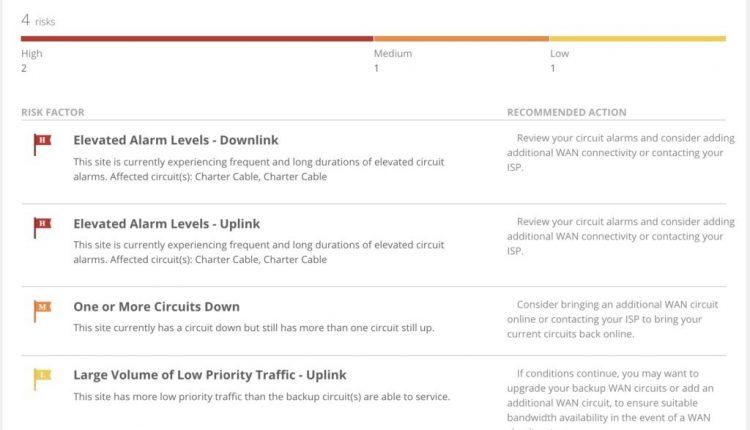
10.08.2020
Bigleaf Networks today launched Risk Monitoring, a new feature within their SD-WAN platform. The new feature uses artificial intelligence to reduce alert noise and make them actionable, addressing one of the most costly and inefficient thorns in the side of IT departments and drives a powerful stake in the ground for the future of artificial intelligence in the network. This kind of contextual alerting will help enable IT-lean organizations to provide the same level of application performance and network reliability traditionally reserved for enterprises with huge IT teams and budgets.
“The complexity of networks in today’s IT-lean enterprises where they have tens or hundreds of cloud applications running across hundreds or thousands of branch and home internet connections has reached a point where all sense of control and excellence has been lost,” said Joel Mulkey, co-founder and CEO, Bigleaf. “People can’t process and troubleshoot the volume of alerts and events on networks anymore. It’s not a matter of not wanting to. It’s that there’s simply too much information, most of which is noise. You’ve got to have intelligent software to solve this problem. By building a platform that takes control of processing and interpreting those events, we’ve now established true network control for our customers.”
Until now, the only way to reduce that noise was to create and manage alerting policies to set limits on the volume, at the risk of missing important signals within the noise. What Bigleaf calls risks are contextualized and interpreted pieces of information about network status and behavior that are observed and monitored by the company’s network and devices. Each of these risks specifically highlights patterns of events, status conditions, or other scenarios that pose a risk to a customer’s business and their site’s continuity or uptime. Each risk alert is designed to give customers an easily understood explanation and path to resolution so that risk can be resolved. Bigleaf’s dashboard includes a new widget that shows the number of risks a site currently has triggered and highlights the top three risks for that site.
Bigleaf Risk Monitoring brings alerting into the modern era by using intelligent software to identify and translate network events into business risks. It is not uncommon for IT and operations managers to see hundreds of thousands — and, in some cases, millions — of alert emails each day. In a 2018 survey of IT professionals, security provider Imperva found that nearly a third of those surveyed said they received more than one million alerts each day across all of their systems. More than half said they received in excess of 10,000 daily alerts. By using artificial intelligence to interpret high-volume network events into prioritized actionable risks, Bigleaf is able to reduce risk alert noise by as much as fifty percent for average customers.
One Bigleaf customer has only seven IT people managing its 110 locations, a ratio more and more typical in today’s IT-lean enterprises. That one customer generated more than two and a half million network performance alerts last year. “They don’t have time to read and act on two million alerts. So all they can do is ignore most of them and respond to user complaints,” continued Mulkey. “We knew there had to be a better way to give IT-lean organizations all of that important data in a way they could handle, and we knew that it would require software to interpret the data that people wouldn’t have time to.”
The risks Bigleaf monitors span the spectrum from site outages to load balancing across different circuits. Bigleaf exposes a total of twelve different risks in the initial launch of this new feature, including:
- Extended periods of elevated health alarm levels
- Circuit outage(s) that result in only a single circuit remaining up
- Critical traffic volume exceeding the capacity of backup circuits
Site outage
These actionable, risk-focused alerts give IT and network managers a clear path to resolving issues that may exist with their ISP, equipment, or configuration. As an example, a customer with a high volume of high priority traffic could see a risk presented that states their backup circuits do not have sufficient capacity to handle that traffic if their primary circuit fails. In instances of circuit outages or performance issues, getting notified of each individual event does not provide a user with an understanding of if it matters in their environment. So Bigleaf will display and alert on a different risk if the customer loses a single circuit when they have three, versus a risk when they lose all but one circuit and an outage is imminent if it fails.
“This new feature brings incredible relief to daily pain our customers and others in the industry feel. It also brings significant value to our MSP partners who now have a tool that lets them see risks across all of the companies they manage and helps them better determine where they should spend their limited time and resources to keep their customers happy,” continued Mulkey.
Existing Bigleaf customers can access the new Risk Monitoring feature by logging into the Bigleaf web dashboard.
www.bigleaf.net


Comments are closed.